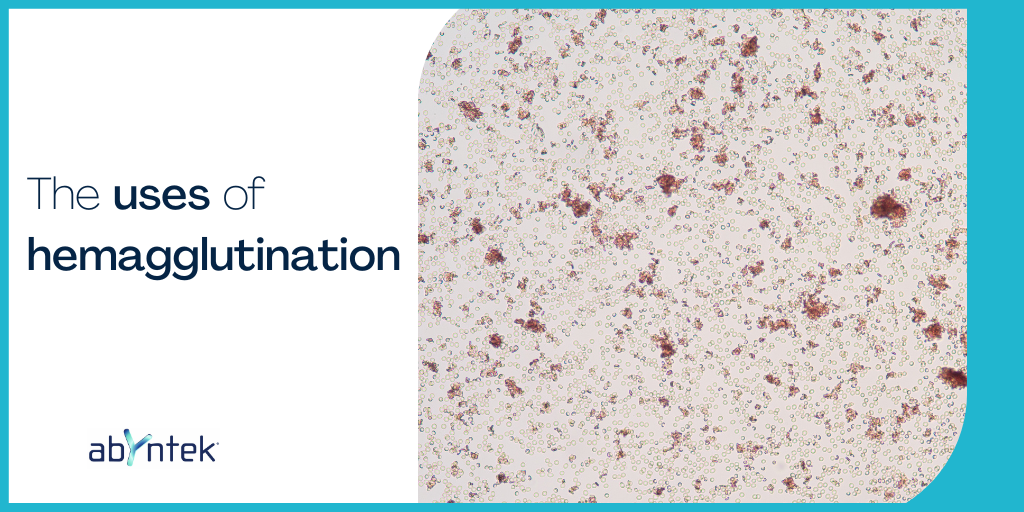Which are the uses of hemagglutination? In this post, ABYNTEK BIOPHARMA explains the different types of agglutination tests available, their usefulness and how to carry them out.
According to the definition, hemagglutination is the agglutination of red blood cells. This agglutination ability of red blood cells is mainly used for the detection and diagnosis of viruses. The advantage of this type of methodology lies in its rapidity and cost-efficient price.
Other uses of hemagglutination are to determine the antibody titer, for the antigenic characterization of viruses, and to select vaccine strains.
How does the agglutination test work?
These tests are based on the ability of encapsulated viruses, and some bacteria, to bind to red blood cells and agglutinate them together.

Which is the agglutination test basis?
These microorganisms have a protein called hemagglutinin (HA) in their envelope, capable of binding to this type of cells through the sialic acid present on their surface. The result is clumping or agglutination of the erythrocytes.
Not depending on any activity, agglutination occurs both in living organisms and in microorganisms that may be inactivated, but not destroyed.

How is a hemagglutination test carried out?
It consists of incubating a microorganism, typically a virus, in saline solution, with the erythrocytes. After at least 30 minutes the reaction can be observed.
If serial dilutions of the virus or bacteria sample are made, facing the same concentration of erythrocytes, it is possible to quantify the amount of the organism present in the sample hemagglutinating units (HAU).
How ARE AGGLUTINATION RESULTS read?
If agglutination has occurred, the red blood cells disperse. This dispersion is observed as a kind of homogeneous turbidity, in such a way that the well or tube is colored red.
If agglutination has not occurred, which indicates that there has been no binding of the microorganism to the erythrocyte, they precipitate by gravity to the bottom of the tube or well. Precipitation is observed as a red dot in the middle of the tube or well.

Which type of agglutination tests are available?
Hemagglutination
This test, as previously mentioned, is used to determine the presence or absence of a virus or bacteria in a sample, and to estimate its concentration. However, it does not allow to know specifically microorganism species.
Hemagglutination inhibition
This technique uses specific antibodies that bind the microorganism, thus blocking the unions of the same to the erythrocytes.
Hemagglutination inhibition can be used both to detect the microorganism and its specific antibody.
For viruses, a battery of antibodies against several viruses might be used, to try to determine the agent present in the sample.

Latex agglutination/fixation
This test follows the same principle as the agglutination test, but latex particles instead of erythrocytes are used. Latex particles create a matrix, to which antigens or antibodies are immobilized. As in hemagglutination, binding results in agglutination of the latex particles.
This technique is commonly used to determine the presence of pathogens or auto-antibodies.
Antibody detection by agglutination
This technique combines agglutination with PCR, increasing the sensitivity of the technique. To achieve so, specific capture antigens are conjugated to short chains of synthetic DNA that cannot be amplified by themselves. If the antibodies of interest are present in the sample, they will agglutinate various antigen-DNA conjugates. The proximity of the synthetic DNA strands facilitates ligation and PCR amplification for quantification.
Abyntek Biopharma offers a collection of cells lines from different animals to carry out these experiments, as well as latex beads.
Bibliography
Slieman, Tony A. (2020). [Methods in Microbiology] Immunological Methods in Microbiology Volume 47 || Introduction to immunological techniques in the clinical laboratory , (), 1–16. doi: 10.1016/bs.mim.2020.01.001
Chu, F.S. (2003). Encyclopaedia of Food Sciences and Nutrition | IMMUNOASSAYS | Principles, (), 3242–3248. doi:10.1016/B0-12-227055-X/00625-8
Dacie and Lewis Practical Haematology (Tenth Edition). Wang-Shick Ryu, in Molecular Virology of Human Pathogenic Viruses. Chapter 4: diagnosis and methods, 2017




